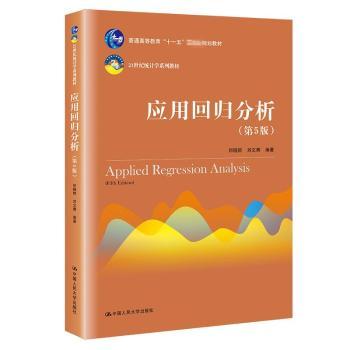内容简介
全书共分10章。第1章对回归分析的研究内容和建模过程给出综述介绍;第2章和第3章详细介绍了一元和多元线回归的参数估计、显著检验及其应用;第4章对违背回归模型基本假设的异方差、自相关和异常值等问题给出了诊断和法,在这一章增加了BOX-COX变换;第5章介绍了回归变量选择与逐步回归方法;第6章多重共线的产生背景、诊断方法、法等方面结合实际经济问题给予讨论;第7章岭回归估计是解决共线问题的一种实用的方法;第8章介绍了主成分回归与偏小二乘,这是第三版新增加的内容;第9章介绍了可化为线回归的曲线回归、多项式回归,以及不能线化的非线回归模型的计算;第10章分别介绍了自变量中含定变量和因变量是定变量的回归问题。
目录
目录
第1章回归分析概述
1.1变量间的统计关系
1.2回归方程与回归名称的由来
1.3回归分析的主要内容及其一般模型
1.4建立实际问题回归模型的过程
1.5回归分析应用与发展述评
思考与练r style="color: rgb(102, 102, 102); font-family: tahoma, arial, "Microsoft YaHei", "Hiragino Sans GB", u5b8bu4f53, sans-serif; font-size: 14px; white-space: normal; background-color: rgb(255, 255, 255);"/>第2章一元线回归
2.1一元线回归模型
2.2参数β0,β1的估计
2.3小二乘估计的质
2.4回归方程的显著检验
2.5残差分析
2.6回归系数的区间估计
2.7预测和控制
2.8本章小结与评注
思考与练r style="color: rgb(102, 102, 102); font-family: tahoma, arial, "Microsoft YaHei", "Hiragino Sans GB", u5b8bu4f53, sans-serif; font-size: 14px; white-space: normal; background-color: rgb(255, 255, 255);"/>第3章多元线回归
3.1多元线回归模型
3.2回归参数的估计
3.3参数估计量的质
3.4回归方程的显著检验
3.5中心化和标准化
3.6相关阵与偏相关系数
3.7本章小结与评注
思考与练r style="color: rgb(102, 102, 102); font-family: tahoma, arial, "Microsoft YaHei", "Hiragino Sans GB", u5b8bu4f53, sans-serif; font-size: 14px; white-space: normal; background-color: rgb(255, 255, 255);"/>第4章违背基本假设的情况
4.1异方差产生的背景和原因
4.2一元加权小二乘估计
4.3多元加权小二乘估计
4.4自相关问题及其处理
4.5BOXCOX变换
4.6异常值与强影响点
4.7本章小结与评注
思考与练r style="color: rgb(102, 102, 102); font-family: tahoma, arial, "Microsoft YaHei", "Hiragino Sans GB", u5b8bu4f53, sans-serif; font-size: 14px; white-space: normal; background-color: rgb(255, 255, 255);"/>第5章自变量选择与逐步回归
5.1自变量选择对估计和预测的影响5.2所有子集回归
5.3逐步回归
5.4本章小结与评注
思考与练r style="color: rgb(102, 102, 102); font-family: tahoma, arial, "Microsoft YaHei", "Hiragino Sans GB", u5b8bu4f53, sans-serif; font-size: 14px; white-space: normal; background-color: rgb(255, 255, 255);"/>第6章多重共线的情形及其处理
6.1多重共线产生的背景和原因
6.2多重共线对回归模型的影响
6.3多重共线的诊断
6.4消除多重共线的方法
6.5本章小结与评注
思考与练r style="color: rgb(102, 102, 102); font-family: tahoma, arial, "Microsoft YaHei", "Hiragino Sans GB", u5b8bu4f53, sans-serif; font-size: 14px; white-space: normal; background-color: rgb(255, 255, 255);"/>第7章岭回归
7.1岭回归估计的定义
7.2岭回归估计的质
7.3岭迹分析
7.4岭参数k的选择
7.5用岭回归选择变量
7.6本章小结与评注
思考与练r style="color: rgb(102, 102, 102); font-family: tahoma, arial, "Microsoft YaHei", "Hiragino Sans GB", u5b8bu4f53, sans-serif; font-size: 14px; white-space: normal; background-color: rgb(255, 255, 255);"/>第8章主成分回归与偏小二乘
8.1主成分回归
8.2偏小二乘
8.3本章小结与评注
思考与练r style="color: rgb(102, 102, 102); font-family: tahoma, arial, "Microsoft YaHei", "Hiragino Sans GB", u5b8bu4f53, sans-serif; font-size: 14px; white-space: normal; background-color: rgb(255, 255, 255);"/>第9章非线回归
9.1可化为线回归的曲线回归
9.2多项式回归
9.3非线模型
9.4本章小结与评注
思考与练r style="color: rgb(102, 102, 102); font-family: tahoma, arial, "Microsoft YaHei", "Hiragino Sans GB", u5b8bu4f53, sans-serif; font-size: 14px; white-space: normal; background-color: rgb(255, 255, 255);"/>第10章含定变量的回归模型
10.1自变量含定变量的回归模型
10.2自变量含定变量的回归模型的应用
10.3因变量是定变量的回归模型
10.4Logistic回归模型
10.5多类别Logistic回归
10.6因变量顺序数据的回归
10.7本章小结与评注思考与练r style="color: rgb(102, 102, 102); font-family: tahoma, arial, "Microsoft YaHei", "Hiragino Sans GB", u5b8bu4f53, sans-serif; font-size: 14px; white-space: normal; background-color: rgb(255, 255, 255);"/>
部分练考答案
附录
参考文献



